Disclosure: Meeple Mountain received a free copy of this product in exchange for an honest, unbiased review. This review is not intended to be an endorsement.
Hanamikoji is a modern classic. Simple yet deep, fiendishly clever and comically uncompromising in its sparse elegance. You have to pity any game growing up in its shadow, the expectations are huge.
Welcome to Hanamikoji: Geisha’s Road.
Note: Hanamikoji: Geisha’s Road launches on Kickstarter on October 26.
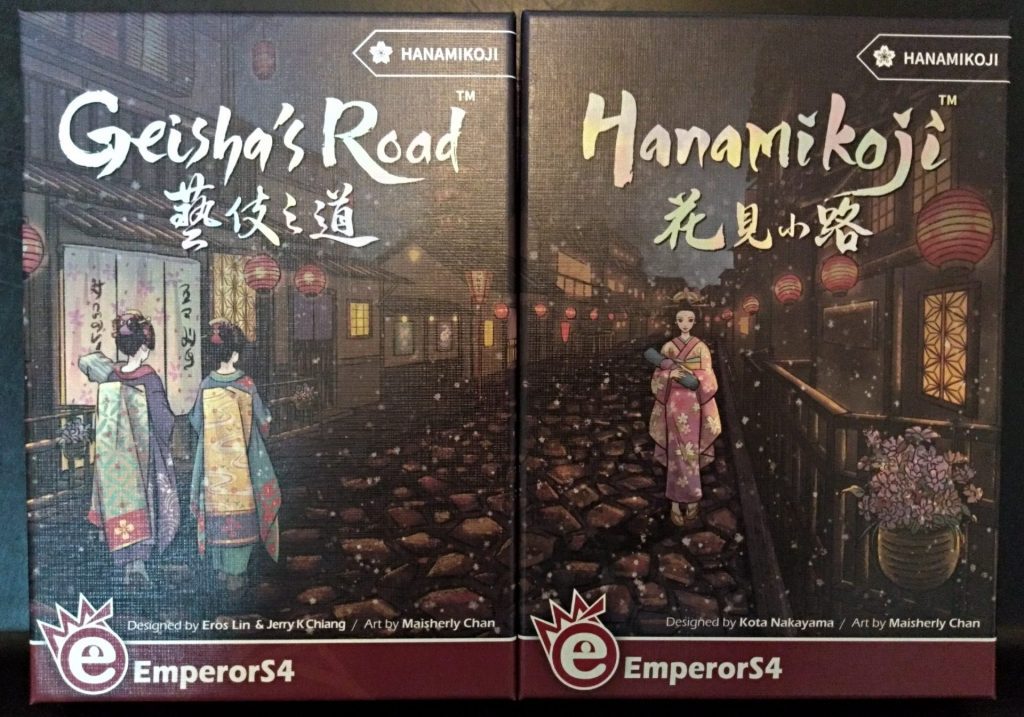
If you’ve ever played Hanamikoji and felt that it was just a clever mechanism in need of a game then Geisha’s Road might be the thing for you. The same basic principles are present: you’re still competing for the favour of geisha (and if the theme makes you uncomfortable, then see my review of Hanamikoji for an explanation of what geisha are and are not), and still restricted by the 4 actions you can take. Other than those similarities though… well, we’re not in Kyoto anymore.
Road Trippin’
On the table between you and your opponent are two arrangements of cards. The first will be familiar to Hanamikoji players: 5 geisha cards arranged in a row. Unlike in the original game, the cards depict the gifts the geisha would like to receive, rather than the geisha themselves. They’re more practical for card play but less evocative.

The second arrangement is a loose pentagon of 5 teahouse cards. These correspond to the geisha cards, and upon each is a small standee depicting its geisha. The geisha move clockwise around the teahouse ring and if they land exactly on their own teahouse they’ll gain 2 to 4 points. During a single round the geisha can return to their own teahouse twice, collecting up to 7 points. Equally, they can fail to land on their home teahouse at all and end up worth just half a point.
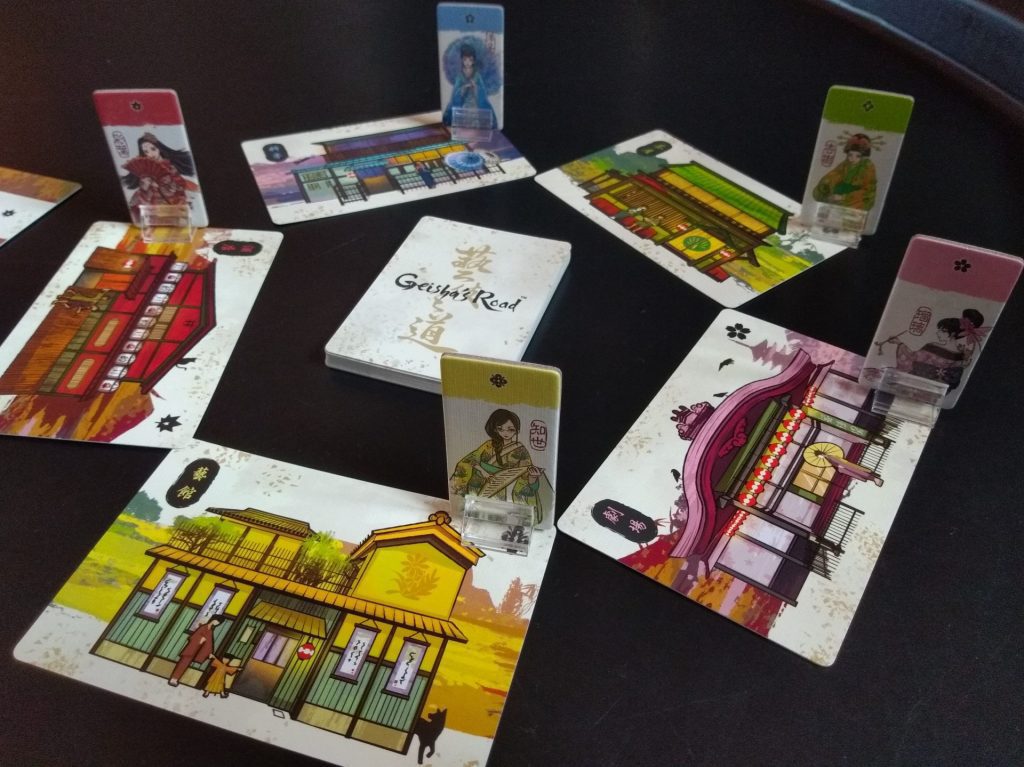
In your hand are 6 gift cards. There are 5 different types of gift cards and, you’ve guessed it, each corresponds to a geisha. There are only 20 cards in total, numbered 1 to 4 for each geisha. When you play a gift card to its corresponding geisha, you simultaneously gain that amount of influence with the geisha and move that geisha’s standee the same number of spaces around the caffeine roundabout. As with Hanamikoji though, how you actually play gift cards is restricted.

Before you are the 4 tiles representing the actions you’re able to take – (i) place 1 card, (ii) discard 1 card and reserve 1 card, or offer you opponent a choice of either (iii) 3 individual cards or (iv) 2 pairs of cards and you keep what they don’t choose. Players alternate turns until each player has taken all 4 actions, in any order they want, at which point the round ends.
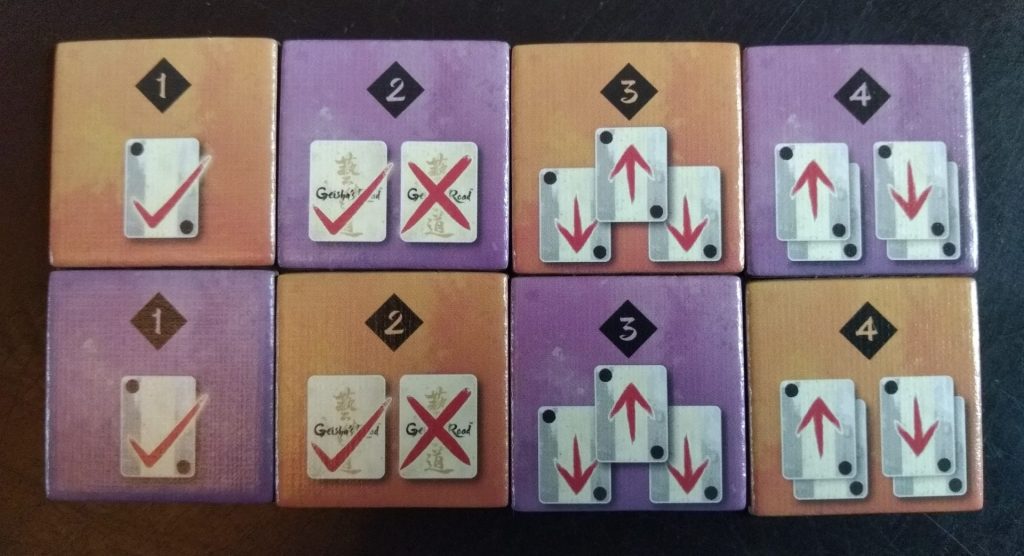
The player with the most influence with a geisha has gained her favour and gets the points (if any) she has collected on her laps of the teahouses. The person with the most points across all 5 geisha wins the round, with the first player to win 2 out of 3 rounds winning the game.
The Long and Winding Road
So is Geisha’s Road a worthy sequel to its elder sibling or a mere pretender to the throne?
I’ll be honest: I didn’t enjoy my first games of Geisha’s Road at all. Despite winning them it didn’t feel like I deserved to or even understood how I had. After 6 undefeated rounds I packed the game away and went to bed with a slightly bad taste in my mouth and a single question in my brain: am I just dumb or am I over-thinking it?
After a few more games it turns out I’m both.
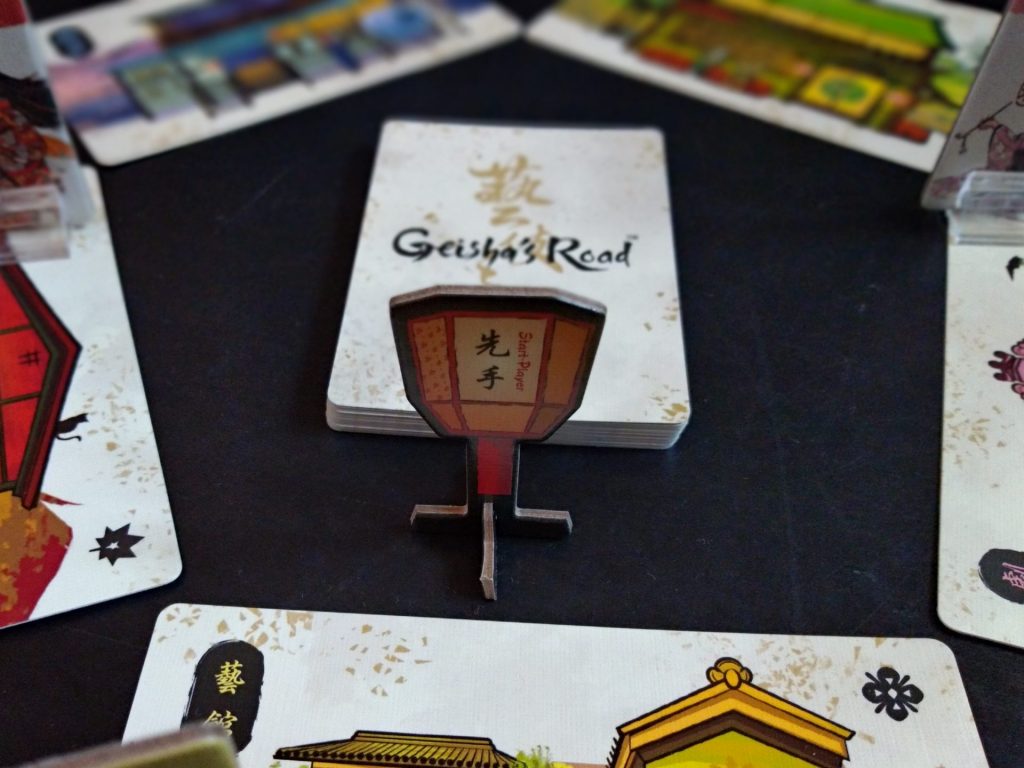
Here’s the thing: Geisha’s Road sounds simple, and it is… right up to the point when it isn’t. Every part of the design twists back in on itself, a Möbius strip in card form.
Let’s illustrate this with the blue geisha. You’re playing blue cards to move the blue geisha to increase her value, which you’ll only receive if your total of blue cards is higher than your opponent’s. It sounds like focusing on winning the blue geisha is a good idea but the order in which the blue cards are played dictates whether the blue geisha scores points. What’s more, if your opponent realises what you’re up to they might intentionally play blue cards in the wrong order or discard the one blue card you need for your plan to work.
Now multiply that by 5 and sprinkle it with 4 awkward actions which limit how you play cards to your side of the row and which give your opponent plenty of opportunities to mess up your plans, intentionally or not.
In your quest to win the game you end up winning worthless geisha, drawing for prized geisha, and increasing the value of geisha whilst simultaneously gifting them to your opponent.

There are layers within layers within layers. Should you focus on getting geisha to land on their home teahouses, or concentrate on winning the geisha, or try to achieve both?
For a time the number 5 seems important: there are 5 geisha, 5 teahouses, 5 types of gift card, and both players will have 5 influence if they’re tied for a geisha. A geisha will return to her home teahouse in 5 movements, and with gift cards numbered 1-4 you can total 5 twice (2+3 and 1+4), meaning a potential of two visits to the home teahouse for points.
Then you realise that 3 seems to matter more – only 3 of the geisha will complete their second lap (the other 2 being scuppered by the 2 discarded cards) so if you can win those geisha then you’re guaranteed points. But which will those 3 geisha be and can you ensure they stop at their teahouse twice or only once?
And so it goes on, your thoughts going round and round like the geisha themselves, fueled by the cards in your hand and those 4 awkward action tiles, trying to untangle the puzzle.
Geisha’s Road makes my brain hurt.

But the curious thing is that after those first unhappy games I felt like I needed to try it again. And then again. I didn’t get closer to finding a perfect approach but I began to slowly enjoy it.
Where in Hanamikoj the best parts of the game hang in the air between you and your opponent, Geisha’s Road’s highlights are split between the puzzle of geisha movement and battle for geisha favour. It feels kinder, still difficult but not the same minimalist zero-sum duel as its predecessor. There isn’t the same feeling of one misstep and you’ve lost. I’m not suggesting it’s gentle but losing isn’t as cruel.
So it was with some trepidation that I introduced the Guests expansion (note, this is a specific expansion for Geisha’s Road, not the 7 mini-expansions that work with both it and Hanamikoji). Adding another layer of complication on a game that I was still only luke warm about didn’t seem like it was going to end well.
Shows what I know.
The Guests should be included in every game, a simple addition that has you collecting sets of guests from teahouses. Previously you only cared about the 1s and 2s because they’re essential for getting the geisha to stop at the teahouses you want, with the best plays being to foist them off on your opponent whilst keeping the 3s and 4s for yourself to win the geisha’s favour.

Now, however, the 1s and 2s are just as important as the 3s and 4, letting you collect guests and almost as many points as the geishas. It changes the game completely, making every decision more interesting. Every card is now tempting, every offer made is full of jewels. Do you take the 4 that helps gain favour or the 1 that lets you collect 2 guests? The Guests expansion asks your brain to work a little harder but since you’ll always collect at least a couple of guests in a round, failure doesn’t cut as deeply.
End of the Road
When you add the Guests expansion, Geisha’s Road is a worthy follow up to Hanamikoji. It’s a much bigger game in every aspect, a main course to the original’s appetiser. That comes with some negatives – it’s slower to set up and reset between rounds, turns are fiddlier, and it takes up a surprising amount of table space. But it also feels more substantial, as if you’ve achieved something significant and earned those points.
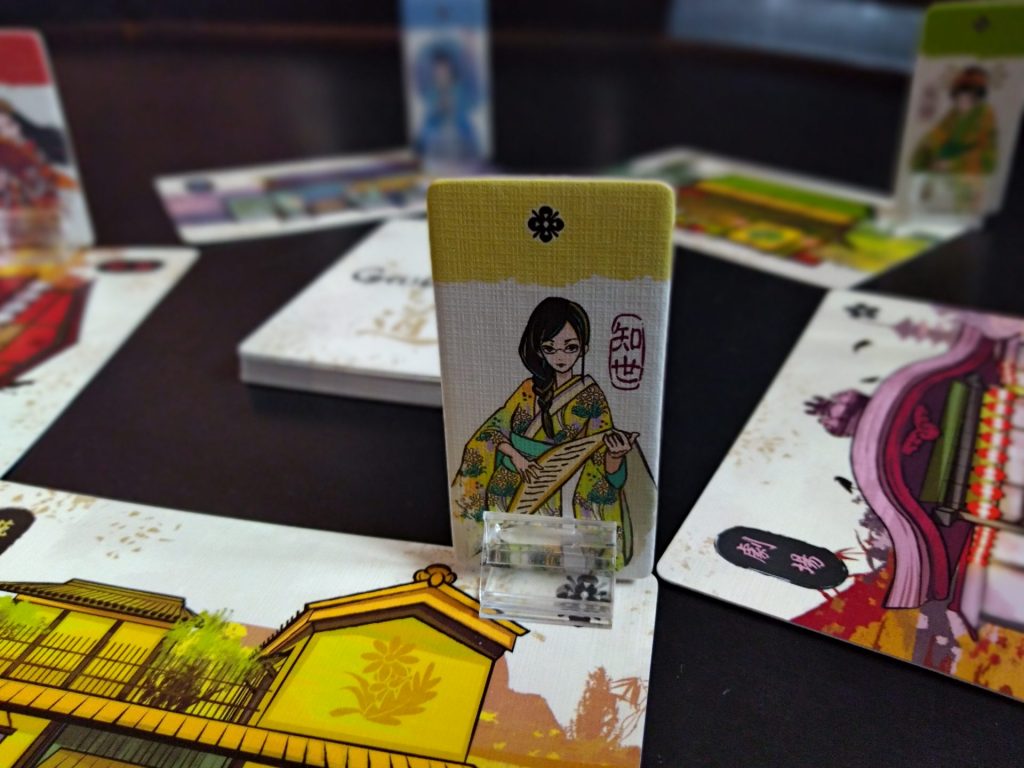
There’s a curious thing about my reaction to these games that sums up their dissimilar design goals: I’ve thought about them both a lot but in very different ways. I remember individual turns and emotions from Hanamikoji – the moments I truly messed up, bamboozled my opponent or was utterly outplayed. But with Geisha’s Road my thoughts have been almost exclusively focused on the gameplay and trying to untangle the ever spinning puzzle at its core. Geisha’s Road puts the duel of Hanamikoji at its heart and then builds a knotty game around that engine for it to power.
In my review of Hanamikoji I described it as an Argentine tango where the two dancers are listening to different music – dramatic but with the potential for a comedic misstep. Geisha’s Road is more like a Viennese waltz – dizzying, deceptively difficult, and when everything is going well the whirling of the dancers, much like the rotating geisha, is entrancing.
Want to find out more about the Hanamikoji series? Check out our reviews of Hanamikoji and the 7 mini-expansions that are compatible with both Hanamikoji and Geisha’s Road.


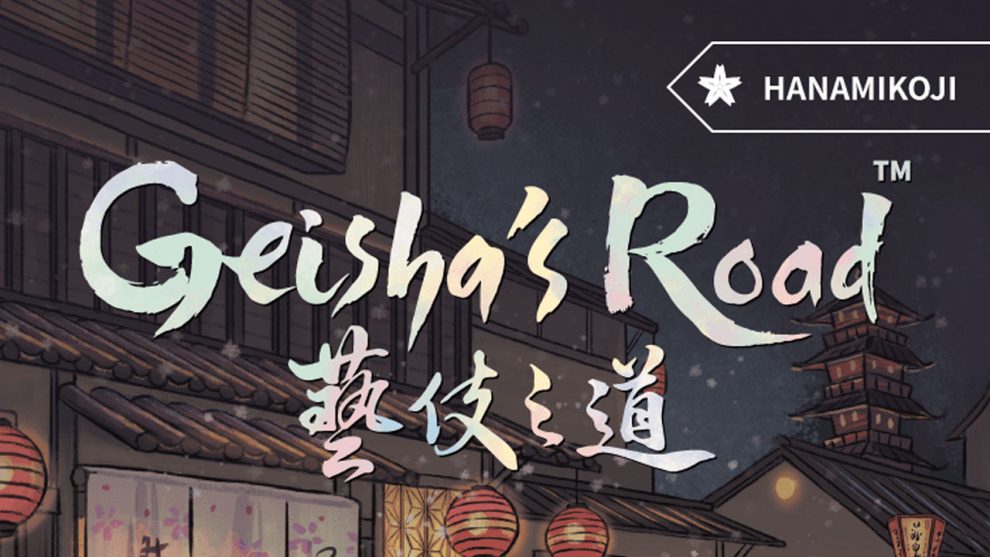








Add Comment